In computer science, specifically software engineering and hardware engineering, formal methods are a particular kind of mathematically rigorous techniques for the specification, development and verification of software and hardware systems. The use of formal methods for software and hardware design is motivated by the expectation that, as in other engineering disciplines, performing appropriate mathematical analysis can contribute to the reliability and robustness of a design.

A Petri net, also known as a place/transition (PT) net, is one of several mathematical modeling languages for the description of distributed systems. It is a class of discrete event dynamic system. A Petri net is a directed bipartite graph that has two types of elements, places and transitions, depicted as white circles and rectangles, respectively. A place can contain any number of tokens, depicted as black circles. A transition is enabled if all places connected to it as inputs contain at least one token. Some sources state that Petri nets were invented in August 1939 by Carl Adam Petri—at the age of 13—for the purpose of describing chemical processes.

In computer science, model checking or property checking is a method for checking whether a finite-state model of a system meets a given specification. This is typically associated with hardware or software systems, where the specification contains liveness requirements as well as safety requirements.
UPPAAL is an integrated tool environment for modeling, validation and verification of real-time systems modeled as networks of timed automata, extended with data types.
In computer science, an abstract state machine (ASM) is a state machine operating on states that are arbitrary data structures.
In digital logic design, an asynchronous circuit is quasi delay-insensitive (QDI) when it operates correctly, independent of gate and wire delay with the weakest exception necessary to be turing-complete.
Business process discovery (BPD) related to business process management and process mining is a set of techniques that manually or automatically construct a representation of an organisations' current business processes and their major process variations. These techniques use data recorded in the existing organisational methods of work, documentations, and technology systems that run business processes within an organisation. The type of data required for process discovery is called an event log. Any record of data that contains the case id, activity name, and timestamp. Such a record qualifies for an event log and can be used to discover the underlying process model. The event log can contain additional information related to the process, such as the resources executing the activity, the type or nature of the events, or any other relevant details. Process discovery aims to obtain a process model that describes the event log as closely as possible. The process model acts as a graphical representation of the process( Petri nets, BPMN, activity diagrams, state diagrams, etc.). The event logs used for discovery could contain noise, irregular information, and inconsistent/incorrect timestamps. Process discovery is challenging due to such noisy event logs and because the event log contains only a part of the actual process hidden behind the system. The discovery algorithms should solely depend on a small percentage of data provided by the event logs to develop the closest possible model to the actual behaviour.
Enterprise engineering is the body of knowledge, principles, and practices used to design all or part of an enterprise. An enterprise is a complex socio-technical system that comprises people, information, and technology that interact with each other and their environment in support of a common mission. One definition is: "an enterprise life-cycle oriented discipline for the identification, design, and implementation of enterprises and their continuous evolution", supported by enterprise modelling. The discipline examines each aspect of the enterprise, including business processes, information flows, material flows, and organizational structure. Enterprise engineering may focus on the design of the enterprise as a whole, or on the design and integration of certain business components.

Willibrordus Martinus Pancratius van der Aalst is a Dutch computer scientist and full professor at RWTH Aachen University, leading the Process and Data Science (PADS) group. His research and teaching interests include information systems, workflow management, Petri nets, process mining, specification languages, and simulation. He is also known for his work on workflow patterns.

An algebraic Petri net (APN) is an evolution of the well known Petri net in which elements of user defined data types replace black tokens. This formalism can be compared to coloured Petri nets (CPN) in many aspects. However, in the APN case, the semantics of the data types is given by an axiomatization enabling proofs and computations on it.
TAPAS is a tool for specifying and analyzing concurrent systems. Its aim is to support teaching of process algebras. Systems are described as process algebra terms that are then mapped to labeled transition systems (LTSs). Properties can be verified by checking equivalences between concrete and abstract system descriptions or by model checking temporal formulas over the obtained LTS. A key feature of TAPAs that makes it particularly suited for teaching is that it maintains a consistent graphical and textual representation of each system. After a change in the graphic notation, the textual representation is updated immediately; but after textual modifications, the update of the graphical representation has to be manually triggered.
Roméo is an integrated tool environment for modeling, validation and verification of real-time systems modeled as time Petri Nets or stopwatch Petri Nets, extended with parameters.
Stochastic Petri nets are a form of Petri net where the transitions fire after a probabilistic delay determined by a random variable.
RP, the International Conference on Reachability Problems is an annual academic conference in the field of computer science.
Rüdiger Valk is a German mathematician. From 1976 to 2010 he was Professor for Theoretical Computer Science (Informatics) at the Institut für Informatik of the University of Hamburg, Germany.
Nets within Nets is a modelling method belonging to the family of Petri nets. This method is distinguished from other sorts of Petri nets by the possibility to provide their tokens with a proper structure, which is based on Petri net modelling again. Hence, a net can contain further net items, being able to move around and fire themselves.
Hartmut Ehrig was a German computer scientist and professor of theoretical computer science and formal specification. He was a pioneer in algebraic specification of abstract data types, and in graph grammars.
Francisco Javier Esparza Estaun is a Computer Scientist. He is a professor at the Technische Universität München.
Signal Transition Graphs (STGs) are typically used in electronic engineering and computer engineering to describe dynamic behaviour of asynchronous circuits, for the purposes of their analysis or synthesis.




